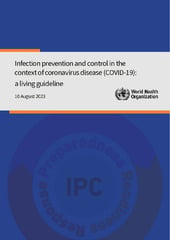Infection
Infection prevention and control in the context of coronavirus disease (COVID-19): a living guideline, 10 August 2023
Overview
The Infection prevention and control in the context of coronavirus disease 2019 (COVID-19): a living guideline consolidates technical guidance developed and published during the COVID-19 pandemic into evidence-informed recommendations for infection prevention and control (IPC). This living guideline is available both online and PDF.
This version of the living guideline (version 5.0) includes the following seven revised statements for the prevention, identification and management of SARS-CoV-2 infections among health and care workers:
- a good practice statement on national and subnational testing strategies;
- a good practice statement on passive syndromic surveillance of health and care workers;
- a good practice statement on prioritizing health and care workers for SARS-CoV-2 testing;
- a good practice statement on protocols for reporting and managing health and care worker exposures;
- a good practice statement to limit in-person work of health and care workers with active SARS-CoV-2 infections;
- a statement on high-risk exposures and quarantine; and,
- a conditional recommendation on the duration of isolation for health and care workers.
Understanding the updated section
Prevention of infections in the health care setting includes a multi-pronged and multi-factorial approach that includes IPC and occupational health and safety measures and adherence to Public Health and Social Measures in the community by the health workforce. The underlying infection prevention and control strategy of this section is the notion that early identification of symptomatic cases, testing and quarantining/isolating health and care workers decreases the risk of nosocomial infection to patients and to other health and care workers.
Version 5.0 of the living guideline supersedes the previous guidance on the Prevention, identification and management of health worker infection in the context of COVID-19 issued in October 2020.

